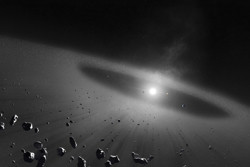Where planets are formed
The 'Formation and evolution of planetary systems' (DISKEVOL) project bridged the gap between two different approaches in the study of protoplanetary disks. The first focuses on the millimetre and sub-millimetre part of the spectrum to derive information about the abundance of different gases within the disks. The focus of the second is on optical and infrared observations to study the dust particles. The individual pieces of information from the dust and gas components had never before been combined. In this light, the DISKEVOL scientists developed some of the most powerful software codes, ProDiMo and MCFOST, to model dust and gas observations of protoplanetary disks. In particular, observations from the Herschel space observatory were modelled as coherently as possible. Herschel, a cutting-edge European space observatory, carries the largest infrared telescope ever flown in space. The brightest spectral lines from disks lie in the infrared and arise at distances up to a hundred astronomical units, where planets are expected to form. DISKEVOL scientists employed two parallel and complementary approaches. They statistically compared the entire sample of Herschel observations from gas-rich protoplanetary disks through to gas-poor debris. In addition, sources with high-quality observational data of spectral lines and continuum spectra were selected to determine the physical and chemical conditions within disks. The signatures of the dust and gas component were then interpreted with respect to the output of theoretical simulations using varying disk parameters. The unprecedented information obtained about protoplanetary disks were presented in 40 peer-reviewed papers published in international papers. This highlights the significance of DISKEVOL project outcomes to the scientific community. By addressing key questions on the timescales of gas and dust evolution, the DISKEVOL database has transformed our current understanding of planet formation. DISKEVOL project outcomes will prove particularly useful after the development of the cutting edge James Webb space telescope and the Atacama Large Millimeter Array.







